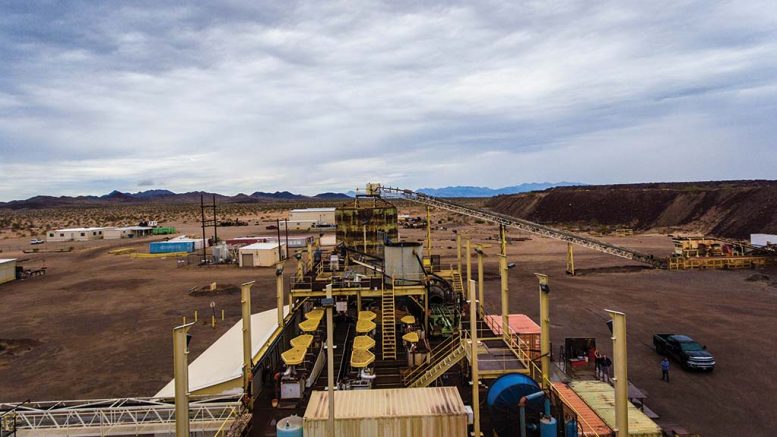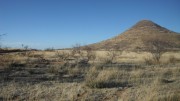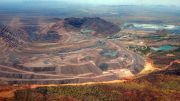Kerr Mines (TSX: KER; US-OTC: KERMF) will finance the restart of production from its Copperstone gold mine in Arizona with the help of a US$18 million streaming deal with Star Royalties.
Production is targeted to begin in the fourth quarter of 2021 from the fully permitted mine, which Kerr Mines acquired in 2014 through an all-share acquisition of American Bonanza.
Copperstone, situated in western Arizona’s LaPaz County and within the Walker Lane belt, about a two and a half hour drive from Phoenix, previously produced about 500,000 oz. gold from an open pit operation.
The Copperstone zone is the underground extension of the same ore body that was historically mined from the Cypress pit in the 1980s at about 3 grams gold per tonne. Previous operators also mined underground for about 14 months but encountered challenges because they didn’t do enough development and delineation drilling while also not having appropriate ore controls in place, according to Giulio Bonifacio, Kerr Mines’ CEO.
“If you looked at the project historically and what’s been spent by predecessor companies and Kerr Mines, you’re looking at sunk costs of greater than US$110 million, and that creates the opportunity that will allow for a restart within a relatively short period of time,” Bonifacio said in an interview, noting the project already had a 600-tonne-per-day mill, a tailings facility, 4,300 metres of underground development and site facilities when Kerr acquired it. “It’s also in the American southwest and fully permitted and infrastructure already in place which is simply not easy to replicate.”
Under the stream agreement, Kerr Mines will receive the first US$6 million installment on closing, with the second tranche of US$6 million issued in February 2021 and the final US$6 million payable before April 2021.
Star Royalties will purchase refined gold equal to 9.9% of gold produced until it receives 21,000 ounces, then 3.3% of gold produced until it receives a cumulative 27,200 oz. Star will then receive 1.2% of the gold produced over the remaining life of mine. On top of the US$18 million, Star will provide a cash payment to Kerr for each ounce of gold delivered equal to 25% of the average London Bullion Market Association spot price.
“The reality is Star Royalties stepped in and did extensive due diligence,” and have been “very reasonable in the way the financing was structured,” said Bonifacio. “If you’re an existing shareholder this is a non-dilutive transaction, which is extremely beneficial. That’s clearly one of the benefits of this form of financing.”
What’s more, said Bonifacio, Kerr Mines has gained “a financial partner,” in the process, and “our success is their success.”
The current mine life stands at four and a half years at a gold price of US$1,250 per oz., but the company believes its drill program will increase the mine life to about eight years and plans to update the resource estimate based on results from its 2019 and 2020 work programs.
Kerr Mines estimates that the resource continues down dip from the historic pit into the Copperstone and Footwall zones, where measured and indicated resources currently stand at 276,100 oz. gold (1.12 million tonnes grading 7.63 grams gold per tonne) and another 145,700 oz. gold in the inferred category (666,000 tonnes grading 6.81 grams gold).
In August, after closing a $5 million bought deal financing, the company unveiled its resource and reserve expansion drill program for the year, which consists of up to 10,000 metres. The goal is to add resources along all sections encompassing the current resource strike length of over 1,500 metres.
In the Copperstone Zone, underground core drilling of up to 3,200 metres will utilize 4,300 metres of existing underground development and workings to focus on stepping out along strike and dip to target the D and C zones.
The work program includes reverse circulation drilling from surface of up to 1,500 metres that will use the extensive access provided by the historic open pit to target areas of the Copperstone Zone that are not accessible from the underground workings.
In the Footwall Zone, discovered from underground drilling in 2018, the company is conducting underground core drilling of up to 1,000 metres that will target resources down dip and along strike, while reverse circulation continues from surface with up to 2,800 metres planned.
Surface reverse circulation drilling of up to 1,500 metres is also planned in the South West Zone, about 900 metres to the southwest of the pit.
Highlights from 2019 drilling underground in the Copperstone Zone included 16.8 metres of 40 grams gold; 10.7 metres of 17.49 grams gold; 16.8 metres of 8.25 grams gold; 6.1 metres of 15.91 grams gold; and 12.2 metres of 11.70 grams gold.
In addition to the mine, Kerr holds a 50 sq. km land position, which Bonifacio said hosts a number of prospective targets offering additional upside that warrant further follow-up drilling.
“There are a number of follow-up targets beyond the two underground zones,” he noted. “There are many other targets outside of that footprint that we think will create other opportunities. It’s apparent that you have the benefit of what you can add on the underground targets and you also have other targets worth chasing.”
Bonifacio, who joined the company about fourteen months ago, and previously founded Nevada Copper (TSX: NCU; US-OTC: NEVDF) in 2005, remaining as its CEO until 2018, said working in the southwestern U.S. offers many advantages.
“If you look at Nevada and Arizona, they are two states that are very pro-mining and there’s a wealth of existing infrastructure,” he said, including a highly skilled labour pool, which means “you don’t need to fly people in and fly them out.”
At the end of the day, he noted, “there just aren’t that many projects in the U.S. that can be brought into production in a relatively short period of time.”
Directors and insiders own about 34% of the company, funds and family offices hold another 30%, and retail investors 36%, according to the company’s latest corporate presentation.
Over the last year, Kerr Mines has traded in a range of 9.5¢ and 18¢ and at presstime was trading at 15¢. The company has about 346 million common shares outstanding for a market cap of about $52 million.






Be the first to comment on "Kerr Mines strikes financing deal with Star Royalties"